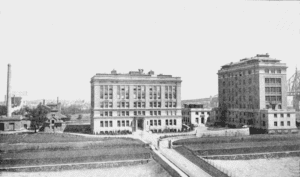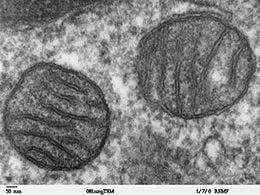Adil Menon
Brookline, Massachusetts, United States
 |
| The Rockefeller Institute |
In 1995 Nobel-winning cell biologist George Palade stated that “a newborn baby needs, of course, a friendly, comfortable cradle, which was provided by the Rockefeller Institute for Medical Research and thus became the American cradle of cell biology.”[1] This essay explores the unique aspects of this cradle, which nurtured the nascent field of cell biology and fostered such ground breaking insights as the oncogenic potential of viruses, the revelation of DNA as the genetic material of heredity, and the structure of mitochondria.
One key aspect of the Rockefeller Institute that helped to foster the growth of cell biology was the close integration of the laboratory and the hospital. This interaction stood in stark contrast to much of early academic biology, which sought to “see biological research freed from the influence of the hospital.”[2] Rockefeller from its inception held the belief that “men who were studying disease clinically … had the right to go as deeply into its fundamental nature as their training allowed.”[3] The merits of this policy are perhaps best illustrated in the person of Albert Claude, MD. Claude initially came to Rockefeller because he wanted “to study with Rouse ‘on the tumor which carries his [Rouse’s] name.’”[4] While engaged in this effort Claude greatly improved his purification technique. Eventually the tumor agent was purified to a degree even greater than that of animal viruses. These efforts saved not only the chicken tumor work from being shut down but also propelled the research of Albert Claude himself in new directions. These efforts eventually lead to the isolation of microsomes, the discovery that microsomes contained the bulk of ribonucleoproteins, and groundbreaking electron microscopy work performed in collaboration with Keith Porter and Edward Pickels. Arguably more crucial, the shift to centrifugation allowed both Claude and the Rockefeller Institute to usher in a new era where “breaking up of that gorgeous structure” was no longer taboo.Structural- biochemical cell dissection was born — a new beginning in cell biology.[5]
While connecting the bench to the bedside was the most vital aspect of Rockefeller’s success, other elements of the culture and structure of the Institute were also important. The influences that shaped European research institutes, both in personality and research capacity, played a central role in developing culture at Rockefeller. Looking to Ehrlich’s struggles against anti-Semitism throughout his career as a negative example, the Institute ensured that those slighted by traditional institutions and power structures could find opportunities to thrive. Among the beneficiaries of these policies were Samuel Meltzer, prevented from obtaining academic positions in his native Germany due to his Jewish faith, and Phoebos Levene, a brilliant but eccentric Russian biochemist. Both were able to readily integrate within Rockefeller.[6] Levene would go on to discover the bases that compose DNA. This continued prioritization of talent over factors such as personality or nationality would later allow those like Palade to build their award-winning careers.
 |
| Electron micrograph of cell mitochondria |
The emphasis on a relatively independent staff was also carried across the Atlantic. From the earliest days of the Institute, research was the priority. In an early memorandum, Theobald Smith made it very clear that at minimum “all plans for advanced teaching should be postponed at least five or six years until the laboratory work shall have been …established.”[7] In reality only once in the Institute’s first half century, when Dr. G.W. Ross presented a universally maligned five week course on opsonin and vaccines, did formal teaching occur. An additional asset was the Institute’s broad perspective on what constituted medical research, largely a legacy of Jacques Loeb. “Any kind of investigation that might contribute to the understanding of health and disease, no matter how widely it ranged from the body of a suffering man to subatomic particles” came to be accepted.[8] Striking a further contrast with academic institutions where the trustees were extremely involved in research itself, at Rockefeller “the direction of educational and scientific programs was left to the faculty.” This helped to escape “one of the most depressing conditions” under which early 20th century scientists worked.[9] This divide and the separate budgets it engendered allowed effective work for over four decades.
As Palade noted, Rockefeller served as cradle not only for the innovations that emerged from within its own walls, but for American cell biology. One of the most crucial steps in nurturing o a new field is the creation of common guidelines. This process fosters the transformation of a group into a distinct field and precludes the need for any one individual to reinvent the field. As phrased in the Rockefeller School, in the absence of a standard of practice “scientists would be hobbled, like cartographers trying to make an atlas according to differing incompatible conventions.”[10] A large part of Rockefeller’s success and eventual reputation stems from an ability to control this process in crucial techniques like electron microscopy. The dominance of the Rockefeller Institute’s methodology was not due to any inherent scientific advantage;instead it was very much Mertonian. Rockefeller, due to its ability to weather the conditions of depression and wartime, was able to serve as a model to the biomedical research intuitions of the postwar period, who due to increases in government support could “afford …rich material infrastructure.”[11] As a consequence, the Rockefeller group built an influential social network that adopted and disseminated their methods.[12] This influence is markedly apparent on the foundation of the American Society for Cell Biology. Porter played a central role in almost every aspect of the process and was offered and declined the presidency of the new society. Among the first elected councilors of the ASCB were George Palade, Clifford Grobstein, and of course Porter. Through these and other professional networks the Rockefeller method rose to the fore across American Biology.[13]
Another vital step in the birth of a new field is the establishment of specialized journals and institutions; Rockefeller was able to dominate this process as well. Continually disappointed by the inability of the existing literature in anatomy and morphology to present high quality electronmicrographs, Porter and others determined that their new discipline required a journal to house and disseminate its findings. The founding of the Rockefeller Institute Press allowed them to make their dreams material, and the Journal of Biophysical and Biochemical Cytology was born. The influence of Rockefeller scientists over this new field and its journal was enormous. Porter served as the original managing editor while Palade decided which editors would read which manuscripts.[14] With a growth in interest, the use of the electron microscope, and the sheer volume of submissions, the founders soon realized “a new world was opening for exploration” and a community of purpose was formed. They also realized that they were dealing with an entirely new field; therefore in 1962 cell biology came into its own accompanied by an eponymous journal, which it was hoped would “survive and prosper for many decades” with Rockefeller taking the lead.[15]
The Rockefeller model, though effective, was indisputably far from perfect. The Institute’s self-published history points out some of the greatest foibles within the system. The structure of distinct laboratories under the guidance of a single eminent investigator eventually led to cloistral exclusiveness and at times the suppression of junior scientists’ initiative. This insularity was further bolstered by the lack of academic roles. While such a system had initially allowed foreign researchers and those not suited for teaching to find a place, by midcentury it served only to produce intellectual isolation, a problem aggravated by a dearth of young researchers. Much of the Rockefeller model’s enervation can also be tied to social factors. The world around the Institute had shifted. By the 1950s many medical schools not only allowed but encouraged research by their professors, while at the same time offering research posts to those who would or could not teach.[16] The need for an isolated research institute had passed. For all these flaws, however, it is undeniable that the Rockefeller Institute more than accomplished its goals of adding to the sum total of human knowledge in medicine and scientific observation. The Rous sarcoma and Avery’s work on genetics are integral facets of biology. Those within the biomedical community cannot help but acknowledge Palade’s elucidation of mitochondrial structure and pioneering electromicroscopic techniques. Beyond the works of individuals, the total output of an institution far greater than the sum of its parts birthed new ways of thinking and tools with which to elucidate the world’s mysteries. Rockefeller was hardly less successful in training. Despite the absence of formal teaching, the opportunity to work with the scientists that filled Rockefeller represented a learning opportunity of the highest order. This education, measured not in degrees but “by the records of men’s careers,” shaped American science.[17] In 1953 two hundred men that had trained at Rockefeller served as full professors or the equivalent rank across thirty-one states and sixteen nations on five continents.
The question of how to conduct good and successful science will always be central to human progress. The historical lessons of the Rockefeller Institute’s successes and failures are among the best available sources in the search to creatively adapt science policy to the changing world of the twenty-first century and beyond.
Notes
- Carol L. Moberg, Entering an Unseen World: A Founding Laboratory and Origins of Modern Cell Biology, 1910-1974. New York, New York: Rockefeller Press, 2012.
- Lily E. Kay,The Molecular Vision of Life Caltech, the Rockefeller Foundation, and the Rise of the New Biology. New York, New York: Oxford University Press, 1993.
- Moberg
- Moberg
- Moberg
- Moberg
- Moberg
- Moberg
- Corner, George W. A History of the Rockefeller Institute, 1901-1953; Origins and Growth. New York, New York: Rockefeller Institute Press, 1964.
- Mulvey, T. “Picture Control: The Electron Microscope and the Transformation of Biology in America, 1940–1960.” Endeavour: 37-38.
- Mulvey
- Mulvey
- Moberg
- Moberg
- Monerg
- Moberg
- Moberg
Works Cited
- Corner, George W. A History of the Rockefeller Institute, 1901-1953; Origins and Growth. New York, New York: Rockefeller Institute Press, 1964.
- Kay, Lily E. The Molecular Vision of Life Caltech, the Rockefeller Foundation, and the Rise of the New Biology. New York, New York: Oxford University Press, 1993.
- Moberg, Carol L. Entering an Unseen World: A Founding Laboratory and Origins of Modern Cell Biology, 1910-1974. New York, New York: Rockefeller Press, 2012.
- Mulvey, T. “Picture Control: The Electron Microscope and the Transformation of Biology in America, 1940–1960.” Endeavour: 37-38.
- Wright, Susan. “Recombinant DNA Technology and Its Social Transformation, 1972-1982.” OSIRIS, 1982, 303-06.
ADIL MENON received his Master of Bioethics degree from Harvard Medical School in 2017. Prior to this he graduated from the University of Chicago with both general honors and departmental honors in the History, Philosophy, and Social Science of Science and Medicine (HIPS) with thesis work centered on addressing disparities in research participation between different ethnic groups.

Leave a Reply